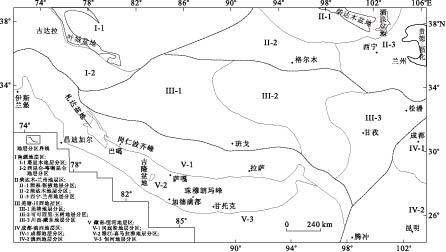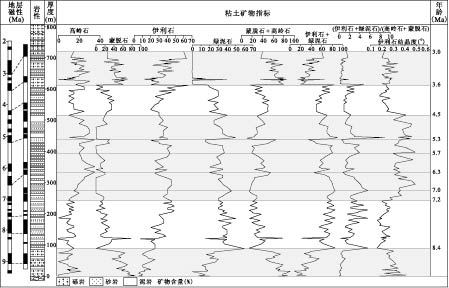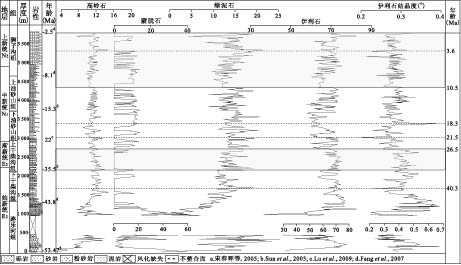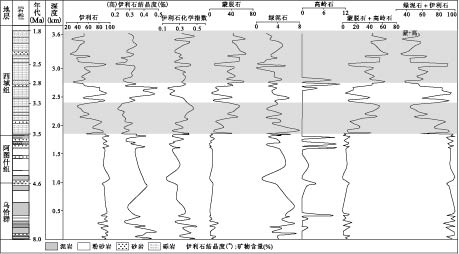Paleoclimate Evolution of the Qinghai-Tibet Plateau since the Cenozoic
-
摘要: 为探究青藏高原的气候环境演化, 对青藏高原不同部位的盆地沉积物的粘土矿物特征进行深入系统的研究.结果表明, 古新世阶段—始新世阶段时期, 青藏高原古气候以行星风系居主导地位, 青藏高原北部以温暖和季节性干旱为特征.柴达木地区在~36 Ma的降温事件则明显早于全球降温事件(~34 Ma)近2 Ma.在渐新世(34~23 Ma)期间, 古气候以干旱炎热为特征, 但气温相对要低于始新世.在中新世—上新世(23.0~2.6 Ma)期间, 青藏高原北缘的柴达木、循化盆地均在~21.5 Ma发生气候变冷事件, 而8~7 Ma的气候变化事件遍及整个青藏高原.在藏南的吉隆盆地、青藏高原西北部的叶城盆地, ~1.8 Ma之前的盆地沉积物中仍然有相当高含量的蒙脱石, 说明这些地区在~1.8 Ma之前, 虽然总体上气候变冷、变干, 但仍然处于一种相对湿润的气候环境.Abstract: Clay mineralogy of sediments of the basins in different locations of the Qinghai-Tibet plateau was investigated to reveal the paleoclimate evolution in Tibet. Our results show that the planetary wind system prevailed over the Paleocene-Eocene in Tibet. A rapid cooling in Qaidam was found in ~36 Ma, prior to the global cooling event by ~2 Ma. In the Oligocene, paleoclimate was warm and dry and the temperature was lower than that of the previous stage. In Miocene-Pliocene period cooling event was found in ~21.5 Ma in Qaidam and Xunhua basins, northeastern Tibet. Climate change in 8-7 Ma occurred in the whole Qinghai-Tibet plateau. In Gyirong, southern Tibet and in Yecheng, western Tibet, smectite occurred in a certain amount in the sediments prior to ~1.8 Ma, indicating that climate was relatively humid in these regions prior to ~1.8 Ma though the climate changed into cool and dry in the Qinghai-Tibet plateau.
-
Key words:
- Qinghai-Tibet plateau /
- Qaidam basin /
- Zhada basin /
- Yecheng basin /
- clay mineral /
- paleoclimate
-
图 1 青藏高原及邻区沉积盆地地层分区(据张克信等,2008修改)
Fig. 1. Stratigraphic regions of the remnant basins in the Tibetan plateau
-
An, Z.S., Huang, Y.S., Liu, W.G., et al., 2005. Multiple expansions of C4 plant biomass in East Asia since 7 Ma coupled with strengthened monsoon circulation. Geology, 33: 705-708. doi: 10.1130/G21423.1 An, Z.S., Kutzbach, J.E., Prell, W.L., et al., 2001. Evolution of Asian monsoons and phased uplift of the Himalaya-Tibetan plateau since Late Miocene times. Nature, 411(6833): 62-66. doi: 10.1038/35075035 An, Z.S., Zhang, P.Z., Wang, E.Q., et al., 2006. Changes of the monsoon-arid environment in China and growth of the Tibetan plateau since the Miocene. Quaternary Sciences, 26(5): 678-693 (in Chinese with English abstract). Cerling, T.E., Harris, J.M., MacFadden, B.J., et al., 1997. Global vegetation change through the Miocene/Pliocene boundary. Nature, 389: 153-158. doi: 10.1038/38229 Clift, P.D., Hodges, K.V., Heslop, D., et al., 2008. Correlation of Himalayan exhumation rates and Asian monsoon intensity. Nature Geoscience, 1: 875-880. doi: 10.1038/ngeo351 DeCelles, P.G., Quade, J., Kapp, P., et al., 2007. High and dry in Central Tibet during the Late Oligocene. Earth and Planetary Science Letters, 253: 389-401. doi: 10.1016/j.epsl.2006.11.001 Guo, Z.T., Ruddiman, W.F., Hao, Q.Z., et al., 2002. Onset of Asian desertification by 22 Myr ago inferred from loess deposits in China. Nature, 416: 159-163. doi: 10.1038/416159a Hong, H.L., Zhang, K.X., Li, Z.H., 2009. Climatic and tectonic uplift evolution since ~7 Ma in Gyirong basin, southwestern Tibet plateau: clay-mineral evidence. International Journal of Earth Sciences. doi: 10.1007/s00531-009-0457-x Huang, C.X., 1994. Comparison study of paleovegetation and paleoclimate in South and North Kunlun Mountains in Pliocene. Science in China (Ser. B), 37(12): 1489-1498. Li, J.J., Fang, X.M., Pan, B.T., et al., 2001. Late Cenozoic intensive uplift of Qinghai-Xizang plateau and its impacts on environments in surrounding area. Quaternary Sciences, 21: 381-391 (in Chinese with English abstract). http://www.researchgate.net/publication/284098400_Late_Cenozoic_intensive_uplift_of_Qinghai-Xizang_Plateau_and_its_impacts_on_environments_in_surrounding_area Li, J.J., Wen, S.X., Zhang, Q.S., et al., 1979. A discussion on the period, amplitude and type of the uplift of the Qinghai-Xizang plateau. Science in China (Ser. A), 22(11): 1314-1328. Liu, D.S., Zheng, M.P., Guo, Z.T., 1998. Initiation and evolution of the Asian monsoon system timely coupled with the ice-sheet growth and the tectonic movements in Asia. Quaternary Sciences, 3: 194-204 (in Chinese with English abstract). Lu, H.J., Xiong, S.F., 2009. Magnetostratigraphy of the Dahonggou Section, northern Qaidam basin and its bearing on Cenozoic tectonic evolution of the Qilianshan and Altyn Tagh fault. Earth and Planetary Science Letters, 288: 539-550. doi: 10.1016/j.epsl.2009.10.016 Lu, H.Y., Wang, X.Y., Li, L.P., 2008. Aeolian dust records indicate the linkage of global cooling and Asian drying in Late Cenozoic. Quaternary Sciences, 28: 949-956 (in Chinese with English abstract). http://www.researchgate.net/publication/285746031_Aeolian_dust_records_indicate_the_linkage_of_global_cooling_and_Asian_drying_in_late_Cenozoic Ma, Y.Z., Fang, X.M., Li, J.J., et al., 2005. The vegetation and climate change during Neocene and Early Quaternary in Jiuxi basin, China. Science in China (Ser. D), 48(5): 676-688. Ma, Y.Z., Li, J.J., Fang, X.M., 1998. Pollen assemblage in 30.6-5.0 Ma redbeds of Linxia region and climate evolution. Chinese Science Bulletin, 43(3): 301-304 (in Chinese). doi: 10.1360/csb1998-43-3-301 Molnar, P., England, P., Matinod, J., 1993. Mantle dynamics, the uplift of the Tibetan plateau, and the Indian monsoon. Reviews of Geophysics, 31(4): 357-396. doi: 10.1029/93RG02030 Molnar, P., 2005. Mio-Pliocene growth of the Tibetan plateau and evolution of East Asian climate. Palaeontologia Electronica, 8(1): 1-23. Pan, Y.S., 1999. Formation and uplifting of the Qinghai-Tibet plateau. Earth Science Frontiers, 6(3): 153-163 (in Chinese with English abstract). Rea, D.K., Snoeckx, H., Joseph, L.H., 1998. Late Cenozoic eolian deposition in the North Pacific: Asian drying, Tibetan uplift, and cooling of the northern hemisphere. Paleoceanography, 13(3): 215-224. doi: 10.1029/98PA00123 Saylor, J., DeCelles, P., Gehrels, G., et al., 2010. Basin formation in the High Himalaya by arc-parallel extension and tectonic damming: Zhada basin, southwestern Tibet. Tectonics, 29, TC1004. doi: 10.1029/2008TC002390 Shi, Y.F., Li, J.J., Li, B.Y., et al., 1999. Uplift of the Qinghai-Xizang (Tibetan) plateau and East Asia environmental change during Late Cenozoic. Acta Geographica Sinica, 54: 10-21 (in Chinese with English abstract). Sun, X.J., Wang P.X., 2005. How old is the Asian monsoon system?—Palaeobotanical records from China. Palaeogeography, Palaeoclimatology, Palaeoecology, 222: 181-222. doi: 10.1016/j.palaeo.2005.03.005 Wang, J.L., Fang, X.M., Li J.J., 1999. Eolian sand deposition and its environmental significance in the northeastern margin of the Qinghai-Xizang plateau. Chinese Science Bulletin, 44(24): 2250-2255. doi: 10.1007/BF02885932 Wang, P.X., Zhao, Q.H., Jian, Z.M., et al., 2003. Thirty million year deep sea records in the South China Sea. Chinese Science Bulletin, 48(23): 2524-2535. doi: 10.1007/BF03037016 Xu, Y.M., Hong, H.L., He, Y.J., 2010. Clay mineralogy and its geological significance of sediments in the foreland basin of West Kunlun Mountains. Acta Sedimentologica Sinica, 28(5): 138-147 (in Chinese with English abstract). http://en.cnki.com.cn/Article_en/CJFDTOTAL-CJXB201004001.htm Yin, A., Kapp, P.A., Murphy, M.A., et al., 1999. Significant Late Neogene east-west extension in northern Tibet. Geology, 27(9): 787-790. doi: 10.1130/0091-7613(1999)027<0787:SLNEWE>2.3.CO;2 Yin, K., Hong, H.L., Li, R.B., et al., 2010. Clay mineralogy and its palaeoclimatic indicator of the Late Oligocene and Early Miocene in Xunhua basin. Geological Science and Technology Information, 29(3): 41-48 (in Chinese with English abstract). Zachos, J., Pagani, M., Sloan, L., et al., 2001. Trends, rhythms, and aberrations in global climate 65 Ma to present. Science, 292(5517): 686-693. doi: 10.1126/science.1059412 Zhang, K.X., Wang, G.C., Cao, K., et al., 2008. Cenozoic sedimentary records and geochronological constraints of differential uplift of the Qinghai-Tibet plateau. Science in China (Ser. D), 51(11): 1658-1672. doi: 10.1007/s11430-008-0132-2 Zhang, K.X., Wang, G.C., Ji, J.L., et al., 2010. Stratigraphic realm and sedimentary sequence of Paleogene-Neogene of Qinghai-Tibet plateau and the response on the uplift of the plateau. Science in China (Earth Sciences), 53(9): 1271-1294. doi: 10.1007/s11430-010-4048-2 Zhang, P.Z., Zheng, D.W., Yin, G.M., et al., 2006. Discussion on Late Cenozoic growth and rise of northeastern margin of the Tibetan plateau. Quaternary Sciences, 26: 5-13 (in Chinese with English abstract). Zheng, H.B., Butcher, K., Powell, C., 2002. Evolution of Neogene foreland basin in Yecheng, Xinjiang, and uplift of northern Tibetan plateau—Ⅰ stratigraphy and petrology. Acta Sedimentologica Sinica, 20(2): 274-281 (in Chinese with English abstract). Zheng, H.B., Huang, X.T., Butcher, K., 2006. Lithostratigraphy, petrography and facies analysis of the Late Cenozoic sediments in the foreland basin of the West Kunlun. Palaeogeography, Palaeoclimatology, Palaeoecology, 241(1): 61-78. doi: 10.1016/j.palaeo.2006.06.015 安芷生, 张培震, 王二七, 等, 2006. 中新世以来我国季风-干旱环境演化与青藏高原的生长. 第四纪研究, 26(5): 678-693. doi: 10.3321/j.issn:1001-7410.2006.05.002 黄赐璇, 1994. 上新世时期昆仑山南北古植被和古气候比较研究. 中国科学(B辑), 24(1): 87-93. https://www.cnki.com.cn/Article/CJFDTOTAL-JBXK199401013.htm 李吉均, 方小敏, 潘保田, 等, 2001. 新生代晚期青藏高原强烈隆起及其对周边环境的影响. 第四纪研究, 21: 381-391. doi: 10.3321/j.issn:1001-7410.2001.05.001 李吉均, 文世宣, 张青松, 等, 1979. 青藏高原隆起的时代、幅度和形式的探讨. 中国科学(A辑), 6: 608-616. https://www.cnki.com.cn/Article/CJFDTOTAL-JAXK197906008.htm 刘东生, 郑绵平, 郭正堂, 1998. 亚洲季风系统的起源和发展及其与两极冰盖和区域构造运动的时代耦合性. 第四纪研究, 3: 194-204. doi: 10.3321/j.issn:1001-7410.1998.03.002 鹿化煜, 王先彦, 李郎平, 2008. 晚新生代亚洲干旱气候发展与全球变冷联系的风尘沉积证据. 第四纪研究, 28: 949-956. doi: 10.3321/j.issn:1001-7410.2008.05.018 马玉贞, 方小敏, 李吉均, 等, 2004. 酒西盆地晚第三纪-第四纪早期植被与气候变化. 中国科学(D辑), 34(2): 107-116. https://www.cnki.com.cn/Article/CJFDTOTAL-JDXK200402001.htm 马玉贞, 李吉均, 方小敏, 1998. 临夏地区30.6~5.0 Ma红层孢粉植物群与气候演化记录. 科学通报, 43(3): 301-304. doi: 10.3321/j.issn:0023-074X.1998.03.019 潘裕生, 1999. 青藏高原的形成与隆升. 地学前缘, 6(3): 153-163. doi: 10.3321/j.issn:1005-2321.1999.03.015 施雅风, 李吉均, 李炳元, 等, 1999. 晚新生代青藏高原的隆升与东亚环境变化. 地理学报, 54: 10-21. https://www.cnki.com.cn/Article/CJFDTOTAL-DLXB901.001.htm 王建力, 方小敏, 李吉均, 1999. 青藏高原东北部15 Ma以来的风沙沉积. 科学通报, 44(12): 1326-1331. doi: 10.3321/j.issn:0023-074X.1999.12.020 徐耀明, 洪汉烈, 何雅娟, 2010. 西昆仑山前陆盆地粘土矿物特征及其地质意义. 沉积学报, 28(5): 138-147. https://www.cnki.com.cn/Article/CJFDTOTAL-CJXB201004001.htm 殷科, 洪汉烈, 李荣彪, 等, 2010. 循化盆地晚渐新世-早中新世沉积物黏土矿物特征及其古气候指示意义. 地质科技情报, 29(3): 41-48. https://www.cnki.com.cn/Article/CJFDTOTAL-DZKQ201003007.htm 张克信, 王国灿, 曹凯, 等, 2008. 青藏高原新生代主要隆升事件: 沉积响应与热年代学记录. 中国科学(D辑), 38(12): 1575-1588. doi: 10.3321/j.issn:1006-9267.2008.12.011 张培震, 郑德文, 尹功明, 等, 2006. 有关青藏高原东北缘晚新生代扩展与隆升的讨论. 第四纪研究, 26: 5-13. https://www.cnki.com.cn/Article/CJFDTOTAL-DSJJ200601001.htm 郑洪波, Butcher, K., Powell, C., 2002. 新疆叶城晚新生代山前盆地演化与青藏高原北缘的隆升——Ⅰ地层学与岩石学证据. 沉积学报, 20(2): 274-281. https://www.cnki.com.cn/Article/CJFDTOTAL-CJXB200202014.htm -










 下载:
下载:




